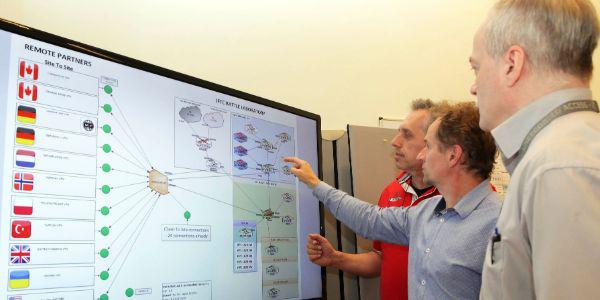Communications Must Carry On
Standardization in communications equipment benefits multinational troops in an international environment by enabling them to communicate, increasing situational awareness for all. NATO’s Federated Mission Networking capabilities, currently in various stages of development, have been paramount in providing consistency within coalition partners in recent missions such as Afghanistan. The lines of communication remain strong because of the joint contribution of the Federated Service Management and Control capability Germany led.
To plan, prepare, build and use mission networks to support federated operations, NATO developed the Federated Mission Networking (FMN) as a conceptional framework that integrates people, technologies and processes. The Federated Service Management and Control (FSMC) proved how a team effort can lead to achieving ambitious goals during the Coalition Warrior Interoperability eXploration, eXperimentation, eXamination, eXercise (CWIX), when development results were demonstrated successfully in an international context.
The German Armed Forces Cyber and Information Domain Command, with assistance from industry partners Atos Information Technology GmbH and IBM Deutschland GmbH, have been designing and implementing the FSMC as part of the development of NATO’s FMN. Throughout the joint approach, the organization’s member states, partner nations Austria and Switzerland, the NATO Communications and Information Agency, NATO strategic commands Allied Command Transformation and Supreme Headquarters Allied Powers Europe, as well as Allied Command Operations, have been involved in its design and incremental implementation.
In just four years, the FSMC has exhibited significant achievements, including stringent open standards and component-based, future-proof architecture and software engineering such as modern design patterns. Resilience-enhancing microservices and software container solutions enable flexible integration of technology independent of individual vendors and products into a framework that meets multinational mission requirements and can pass the accreditations required for deployment.
Germany led the development of the FSMC approach, and it became a success factor for the NATO and FMN communities and its collective ability to act in the future. The German contribution already showed a clear added-value capability that is achievable with moderate to low resource requirements.
The multinational approach the FMN affiliates follow offers decisive advantages for development and use of information technology-based capability modules. First, projects located at this level gain greater political mass. Second, an organization of information technology capability development in multinational working groups generates healthy diversity. Close collaboration and the proven trust resulting from it in the heterogeneous environment adds value. The benefits are experienced not only in multinational missions but also subsequently in successful training and organizing as the troops fight.
With the CWIX as a risk reduction and confirmation event, NATO offers an operational test environment similar to real-world missions that isn’t possible on a national level. From an operational and technical standpoint, the broad and deep competence represented onsite as well as the short distances between participants are particularly convincing.
Because both users and developers are collaborating and cooperating on one project, the open, subject-oriented working atmosphere often allows participants to talk to the affected components developer when challenges arise, one CWIX participant points out.
After the conclusion of the last onsite event before COVID-19 spread worldwide, Germany hosted the CWIX 2020 main planning conference and Finland hosted the FMN Inter-Working-Group Communications and Information Systems Operations Syndicate in January 2020. The international work continued virtually as far as possible and feasible, and CWIX 2020 as well as TIDE Sprint 2020 events were leveraged successfully.
CWIX participation continues to grow. For example, in 2016, only 900 people from 11 nations took part. In 2020, more than 1,500 people from 39 nations participated. On one hand, this growth was made possible by using the existing structures for the organization, and on the other hand by preparing the infrastructure on-site.
The potential value of collaborative events such as these is far from being exhausted. In spiral 5, which is the next maturity level, an increased degree of automation of the FSMC processes and the use of mechanisms like machine learning are planned. The aim is to automate routine tasks, proactively identify data patterns with a view to safety or establish stringent federated change management. Doing so will free up resources and decrease the demand on operational staff so they can focus on other more demanding tasks and troop deployment professionalization can increase.
To build on the past and continue to be successful, it not only is essential to remain agile and capable but also vigilant against risks. Consequently, to reach the degree of maturity envisioned for 2023 and the corresponding NATO standardization for the FSMC, these activities must continue seamlessly and stringently in the future. This work will require financial and personnel support.
While German financial resources have been secured for the mid-term, staff and skill set continuity remains a challenge inherent in the system design. A staff qualitatively and quantitatively mastering the complexity of a profession as dynamic as information technology in changing mission environments is difficult to establish and maintain within military organizations but is necessary to achieve goals in the long term.
Current framework needs must be understood as well as adopted and addressed accordingly. Taking into account the rising demands for expertise and assignment volatility, it is necessary to supplement existing career models with a technically sound and career-promoting part within the competence area of cyber and information technology.
But the courage to tackle the complex task of creating the FSMC and computer information systems security has already paid off for the NATO FMN partner community. Under German leadership, the example of a consolidated digitization project in a military environment has been created. With the FSMC, a complex digital project was successfully advanced on a multinational level, improving the German defense and alliance capability as well as with achieving and maintaining digital sovereignty as a core element of cybersecurity.
With the FMN, FSMC and data-centric security, an opportunity exists for further digital professionalization of the participating nations’ armed forces and therefore the development of cyberspace as a cross-sectional dimension. The joint approach opens a potential that would not be possible in a national solo effort and allows a resilience that is superior to a centralistic-hierarchical model or technological monoculture.
With the help of the FSMC, a vendor- and technology-agnostic test environment can be leveraged that allows low-risk testing of new or not fully developed applications and technologies far into the future. Jointly, nations can continue on this path with determination, courage, energy and a sense of proportion.
The pandemic situation that emerged in early 2020 will likely persist beyond 2021 from a global perspective and possibly repeat in the future. It underlined a demand already identified at the early stages of FSMC capability development when taking lessons learned from real-work missions as foundry for driving requirements for future mission support information technology: the need for self-sufficient, resilient as well as dynamically networked, fully functioning and operational FSMC elements.
The COVID-19 situation again demands the capability and capacity to interconnect across domain boundaries. They could be the only ways to enable a secure and reliable exchange of information and mission execution at the speed of a mission while facing a lack or relocation of specialized information technology staff at every local site during mission execution.
Besides a nearly seamless continuation of activities leading to spiral 5 in 2020, the joint use cases for FSMC and data-centric security have been enhanced during several TIDE Sprint 2020 events toward providing the future capability of enabling and supporting civil-military cooperation, gaining higher efficiency and effectiveness. In 2021, the main scope as planned in the Federated SMC Roadmap will be on federated access, change and communication and information systems security incident management.
Jörg Eschweiler heads cybersecurity and intelligence with Atos’ Public Sector Defense and Intelligence, in Germany. He is a veteran in Federated Mission Networking capability development and Think-Tank for Information Decision and Execution (TIDE Sprint) track lead.
SIGNAL Magazine’s March 2021 issue featured an article detailing the evolution of the FSMC.





Comment
Interesting article with
Interesting article with useful information. But the number of Nations which participated in CWIX 2016 was 22 (not 11) and the EUMS as observer.
Comments